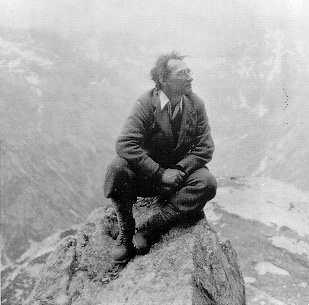Introduction to Practical Criticism

I.A. Richards visiting the Alps, ca. 1930.
Practical criticism is, like the formal study of English literature itself, a relatively young discipline. It began in the 1920s with a series of experiments by the Cambridge critic I.A. Richards. He gave poems to students without any information about who wrote them or when they were written. In Practical Criticism of 1929 he reported on and analysed the results of his experiments. The objective of his work was to encourage students to concentrate on 'the words on the page', rather than relying on preconceived or received beliefs about a text. For Richards this form of close analysis of anonymous poems was ultimately intended to have psychological benefits for the students: by responding to all the currents of emotion and meaning in the poems and passages of prose which they read the students were to achieve what Richards called an 'organised response'. This meant that they would clarify the various currents of thought in the poem and achieve a corresponding clarification of their own emotions.
In the work of Richards' most influential student, William Empson, practical criticism provided the basis for an entire critical method. In Seven Types of Ambiguity (1930) Empson developed his undergraduate essays for Richards into a study of the complex and multiple meanings of poems. His work had a profound impact on a critical movement known as the 'New Criticism', the exponents of which tended to see poems as elaborate structures of complex meanings. New Critics would usually pay relatively little attention to the historical setting of the works which they analysed, treating literature as a sphere of activity of its own. In the work of F.R. Leavis the close analysis of texts became a moral activity, in which a critic would bring the whole of his sensibility to bear on a literary text and test its sincerity and moral seriousness.
Practical criticism today is more usually treated as an ancillary skill rather than the foundation of a critical method. It is a part of many examinations in literature at almost all levels, and is used to test students' responsiveness to what they read, as well as their knowledge of verse forms and of the technical language for describing the way poems create their effects.
Practical criticism in this form has no necessary connection with any particular theoretical approach, and has shed the psychological theories which originally underpinned it. The discipline does, however, have some ground rules which affect how people who are trained in it will respond to literature. It might be seen as encouraging readings which concentrate on the form and meaning of particular works, rather than on larger theoretical questions. The process of reading a poem in clinical isolation from historical processes also can mean that literature is treated as a sphere of activity which is separate from economic or social conditions, or from the life of its author.
The classes which follow this introduction are designed to introduce you to some of the methods and vocabulary of practical criticism, and to give some practical advice about how you can move from formal analysis of a poem and of its meaning to a full critical reading of it. They are accompanied by a glossary of critical terms, to which you can refer if you want to know what any of the technical terms used in the classes mean.
Above all, however, the classes are intended to raise questions about how practical criticism can be used. Do poems look different if they are presented in isolation from the circumstances in which they were written or circulated? Do our critical responses to them change if we add in some contextual information after we have closely analysed them? Do our views of a poem change if we hear it read, if we see the original manuscript, or if instead of simply seeing the words on a page, as I. A. Richards would have wished, we see words on a screen?
To explore these questions, go on to the first class.
Further Reading
A Cambridge University crest by an title indicates that it is by a member or former member of the Cambridge English Faculty
 I. A. Richards, Practical Criticism (London, 1929)
I. A. Richards, Practical Criticism (London, 1929) William Empson, Seven Types of Ambiguity (London, 1930)
William Empson, Seven Types of Ambiguity (London, 1930) John Lennard, The Poetry Handbook: A Guide to Reading Poetry for Pleasure and Practical Criticism (Oxford, 1996)
John Lennard, The Poetry Handbook: A Guide to Reading Poetry for Pleasure and Practical Criticism (Oxford, 1996) Christopher Ricks, The Force of Poetry (Oxford, 1995)
Christopher Ricks, The Force of Poetry (Oxford, 1995) - Chris Baldick, The Social Mission of English Criticism 1848-1932 (Oxford, 1987)

